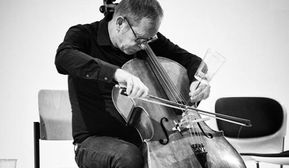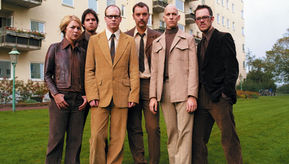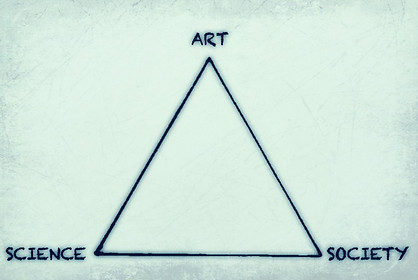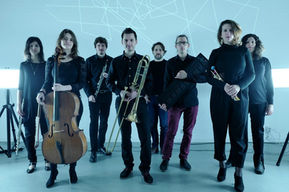RESEARCH PROJECT
VIA BERLIN MASTERCLASS

Welcome Lonely Souls of The Universe!
Here, you can find all the information about the research project I conducted at the Via Berlin's masterclass;
but before I begin with the introduction, I would like to invite you to play the timer below
and listen to the sound around you for 4 minutes and 34 seconds.
You can take off your headphones and close your eyes to increase your listening.
Do you hear it?
INTRODUCTION
For the Via Berlin masterclass, we were asked to come up with a research proposal relating to a social theme and explain why this theme should be explored through music.
The theme of my research was concerned with our life in isolation due to the global pandemic and its implications on the individual’s mental well-being.
Loneliness, economic anxiety and fear for the future have become more acute than ever. There have been increases in domestic violence and depression rates globally. Protests have erupted around the world in response to various socio-political affairs. Distribution of fake news across all media has fed the general public panic. Governments around the world have invested resources into responding to the crises in the healthcare sector without adequately addressing these issues.
At the same time, this period of solitude has sharpened our sensitivity to what had gone unnoticed before, including the world of sound around us. The volume and rhythm of urban life have been re-tuned; and now more than ever, we have the potential to become more fully aware of the other sounds in our lives.
In my research, I decided to explore music that is not mediated by traditional instrumentation, but music that emanates from everyday objects, and to seek the musicality in the sounds of our daily life.

My research question was how does the noise of existence become music and what story does this music create in the context of our currently isolated lives? Of course, there are countless ways to approach this question. Different inspirations helped me to better formulate my approach and envision its potential outcomes.
INSPIRATION

Below are a few of my collected inspirations that demonstrate how music is produced through daily objects.
This varied assemblage served as an initial reference source that informed the practical phase of my research.

Michael Maierhof | Splitting 4 (16 Readymades)
Blue Man Group | Capturing Sounds In New York
FOLI (There Is No Movement Without Rhythm)
Music For One Apartment And Six Drummers
Nadar Ensemble | NOCTURNE
John Cage | Water Walk
CONCEPT DEVELOPMENT
Loneliness was the central theme of this research, influenced by the masterclass’s indicative reading list which included “The Lonely Century: Coming Together in a World that’s Pulling Apart” by Noreena Hertz and “The Lonely City: Adventure in the Art of Being Alone” by Olivia Laing.
While searching for more influential texts around the research theme, I came across the poem "Could Have," by Wisława Szymborska. Her words deeply affected me and led to the first musical instrument choice: balloon – an elastic rubber filled with air that can be popped easily, a strange human invention whose colored round shape is associated with somehow happy feelings. The balloon seemed an apt metaphor for the existential fragility of our time.
During the introduction days, we had several assignments to further develop our ideas. Through stream-of-consciousness writing and sensory perception exercises, I started to gain a more tangible vision of my project.


SMELL
Soap and Rubber
COLOR
Pink, Yellow and Turquoise
SOUND
Pop (not the music; the sound)
Stream of Consciousness
Task 1: “Loneliness. Ritual. A woman sitting in a blue tub. She wears a colorful bathing cap and chats with a rubber duck. She sings. She comes out of the tub and prepares herself. Blows up balloons that produce a lot of sound. She is full of life but there is something very sad about her. She can't leave the house. Outside there seems to be an apocalypse and her whole world concentrating on her rubber duck and her balloons. She celebrates birthday every day. She has no one, but inside her world she has a lot.”
Task 2: “Boiling water, moving water, gentle and continuous flow of tap. Noise of flushing toilet. A duck beeps. Squeaky balloons. A balloon flies through the air. Inflatable balloon. Exploding balloon.”
Task 3: “Colors. Shrinkage. Nightstand. Turns off and on. Quiet. Lots of quiet. Footsteps. Flip flops. A panic scream. A laugher that turns into tears. A cake with one candle. The end of the world has come. Closing eyes. Imagining another place. What will it be?”
Presenting my research proposal and receiving feedback from the group helped me to further develop my ideas. At the time, I was engaged in writing my reflective essay for the BiD module which allowed me to recognize my fear of failure and my inclination toward the world of logic. After presenting my portfolio to the group, I became even more aware of my artistic tendencies. I noticed my sterile aesthetic, restrained emotionality, as well as general conservatism in content and form. This recognition compelled me to abandon my habitual practice. Encouraged by Dagmar and the group, I decided to use this space in order to explore an intuitive and passionate creative approach. Rather than working towards a coherent refined result, I focused on exploration without predetermined decision-making. Soon, the “How” of my research became the “Why.” Implementing impulsive desires as my creative approach engendered a re-examination of ‘queer failure’ and related ideas including pleasure, risk, violence, waste, mess, noise, ugliness, playfulness, foolishness, and randomness. These concepts are usually perceived as negative in the capitalist Western worldview that values productivity and efficiency; but in this research, they were embraced as positive and worthwhile. I wrote these words on cards which were used throughout the research as reference points and constant reminders to avoid drifting into familiar patterns.

To not plan was one of the most difficult rules I placed on my process, requiring both sensitive discipline and an unrestrained attitude. I had to find the delicate balance between allowing things to emerge “organically” and formulating the conditions and steps of the research. I tried to avoid falling into old habits by identifying when I was over-planning things or constructing reason to explain my spontaneous choices. To generate space for the unknown, I avoided creating any obligatory instructions. So that I would not get completely lost, I set some open, mostly technical objectives for a wide frame within which I could operate.
When choosing musical instruments, for instance, I used the following guidelines: (1) Things that can potentially create different sound qualities through interaction. (2) Things that can produce dirt and mess. (3) Things that are not related to one another. (4) Things that can be found for free or at a low price. (5) Things that can be carried in a suitcase.

Above are the objects that I collected in the days leading to the workshop.
RESEARCH METHODS
Using the concept of queer failure to defy the world of logic was the primary research method. I am referring to this creative approach as a method as it requires the development of systematic operations based upon certain principles.
In addition to the principles outlined on the cards above, others were developed throughout the process:
1- Try every idea that comes to my mind without any filter, no matter how "bad" or "wrong" it may be.
This principle unleashed my creativity. Ideas continued to flow, and I felt free to try them without judgment. It also kept me from fixating on any "good" idea so that I allowed more time and space for other ideas to emerge. Using a timer helped divide my time between various experimentations. The presence of the camera was also very beneficial. It encouraged me to try things knowing I can edit them out later.
2- Encourage open meanings rather than impose a certain narrative, emotion or intention.
When I presented the accumulated documentation of my process, the feedback discussion helped me recognize the many possibilities for interpretation that this work allowed. The images that were created in my interactions with the objects stimulated others’ imaginations and associations; since no predetermined narrative, intention or emotion was dictated beforehand. These images also held certain recurring motifs, such as written signs and masks made from different materials, that added another layer to the work.
3- Welcome "mistakes" and "interruptions".
The camera captured things happening in the space that were not part of the improvisations’ given conditions such as people talking to me while I was working. During the editing process, I learned to appreciate those unplanned incidents which suggested additional meanings that would not have been produced otherwise. Unintentionally, it became an opportunity to engage in my master’s research on the relationship between reality and fiction, origin and its representation. In many of the videos, it is unclear if I’m playing a character or being myself, if it’s planned or improvised, if it’s "real" or not. In representing a given reality, mistakes are revealed as more "real" than the organized and refined.
4- Incorporating the whole body in the production of sounds.
Traditionally, the emphasis in a musical piece is placed on the instrument and not so much on the performativity of the body operating it. By virtue of the project’s interdisciplinarity, the way in which the body moves in the operation of the musical object becomes more dominant. For this reason, I choose to wear only underwear and a T-shirt, which can also imply a home-y, isolated feeling.
PROCESS AND DOCUMENTATION
Every day I conducted different sets of improvisations, which were recorded with a camera; and at night, I edited the materials. Editing soon became a creative process in itself that allowed me to observe the process from the outside and to gain new insights into further developments. At the beginning of each day, I sat with Dagmar and watched the previous day’s edited video from which we drew conclusions and formulated new conditions for experimentation. As the process continued, the camera became more than a tool for documenting; it was an audience with which I interacted, turning the solitary process into a performative act.
DAY 1
After arriving at the studio, I spread out all my objects, hung my cards on the back table, and began to play. I moved from object to object like a curious child trying to discover the different sounds that they could produce.
DAY 2
While looking at the recordings from the previous day, I noticed how the space’s layout limited my mobility and distracted my attention. In the scattered cluster of instruments, I moved quickly from object to object without adequately surveying its musical potentiality. Therefore, for the second day, I cleared up the space so that I would work only with one instrument at a time. This new condition enabled me to move more freely and explore many more ways that my whole body could interact with the object. Additionally, after choosing an object, I picked one card at random as a suggestion for the motivation of my interaction and as reminders to deepen my work with each concept. The focus shifted from the object's sound qualities to the possibilities of bodily interaction and the stories these encounters produce.
DAY 3
Since the previous day’s improvisations were quite messy and required extra time for cleaning, I did not complete my exploration with all the objects and cards. Thus, on the third day, I continued experimenting under the second day’s conditions but with two additional adjustments: (1) Avoid imposing any particular narrative, emotion or intention in order to open up possibilities for interpretation. (2) Shift the focus from producing mere sounds to producing rhythms.
DAY 4(A)
The fourth and final day before presenting the research to the group was dedicated to experimentation with different ideas that evolved throughout the process. Strangely, or perhaps not, all were related to birthdays - a shared, recurring human experience that is sometimes very emotionally charged but is rarely addressed in art. Unlike my previous improvisations that were detached from any intentional narrative, this day’s research tried to rediscover the sounds of daily activity in the context of a lonely birthday party.
DAY 4(B)
I continued with the narrative of a birthday celebration for the second improvisation that day, now combining text, sound and singing. The video ironically references Western consumption culture as well as the phenomenon of self-documentation on social media.
DAY 4(C)
The next improvisation was more personal and sincere. Inspired by the evolving narrative, I wrote an autobiographical text. Here, music is not heard, but only seen through my listening. A recorded monologue plays in the background, juxtaposing what the viewer hears against what he/she imagines in the act of seeing.
DAY 5
The final improvisation, which appears at the top of this page, was conducted on the fifth day. I continued playing with the idea of sound as heard through the body as I dance to music that only I can hear.
EPILOGUE
The workshop brought to my attention some of my ingrained habitual artistic tendencies and ethical perceptions. For a while, I have been grappling with the question of how one determines what is “good” or “right,” assuming that “good” or “right” means to invite the consideration of the other. Hitherto, I believed that this acting in good faith can only happen if one acquires adequate knowledge to establish a well-founded position beforehand. This assumption initially seems quite reasonable. Indeed, knowledge is fertile ground for generative acts; for if one does not know what to think, how does one know how to act? Under close scrutiny, however, this assumption raises some fundamental questions. First, what does “adequate knowledge” mean when knowledge production and distribution are driven by socio-political powers that shape cultural consciousness and when what one knows is a subject for an ontological problem as one cannot truly experience reality outside of oneself? Second, are there negative implications in establishing a “well-founded position,” such as adopting a patronizing stance or undermining one’s capacity to accept counter-positions?” Finally, are “adequate knowledge” and a “well-founded position” necessary conditions for acting in a “good” or “right” manner?
Ironically, the lack of any ethical motivation in this research project allowed me to gain new insights regarding my practice and its social role. My research was devoted to creating visual images and sound. There was no pre-given narrative, no social statement; just intuitive, irrational curiosity. The lack of any refined closed meaning enabled different meanings to evolve in the viewer's mind. Being a non-musician freed me from any obligation to create so-called “quality” work, which allowed for unpredictable explorations of what music truly is. Although my project did not lead to any immediate concrete action, it was enough to help me work past my doubts about the importance of my practice. This is not to say that I renounce any social responsibility, creation of meaning or qualifications in my work; but that my approach to them is less restrained, less trapped in an endless circle of questions that paralyze my doing.
During this masterclass, I felt a strong and strange imperative to constantly do. I’m trying to understand what drive kept pushing me to create. I believe it was the permission I gave myself to try and fail and to make as many mistakes as I could without aspiring to any directed result. Instead of approaching the research from the position of one who knows, who can justify any choice and who controls every aspect, I adopted an attitude of not-knowing, not-choosing, not-controlling. The ambition to provide the ‘good’ or ‘right’ product turned out to be less productive than the ambition to fuck it up.
The pursuit of failure was not the only element that influenced my doing. There were other constitutive components: the frame of time and space, the format of sound production through objects, the content of loneliness, and the context of a birthday party; the concept of failure and its derived principles served as a method. All were fundamental parameters that pushed me to create.
Although this work is far from being “finished”, I hope to continue developing this project’s liberated approach throughout my artistic research trajectory. The real challenges for my future practice are to avoid falling into old patterns: to recognize when I reject ideas before testing them or when I rely on logic at the expense of intuition and curiosity. I have a long way to go, and this project was an initial step toward new possibilities. If I run at full strength, stumble, get up and keep running with the same passion; maybe at the end, I’ll understand what I am running for.














